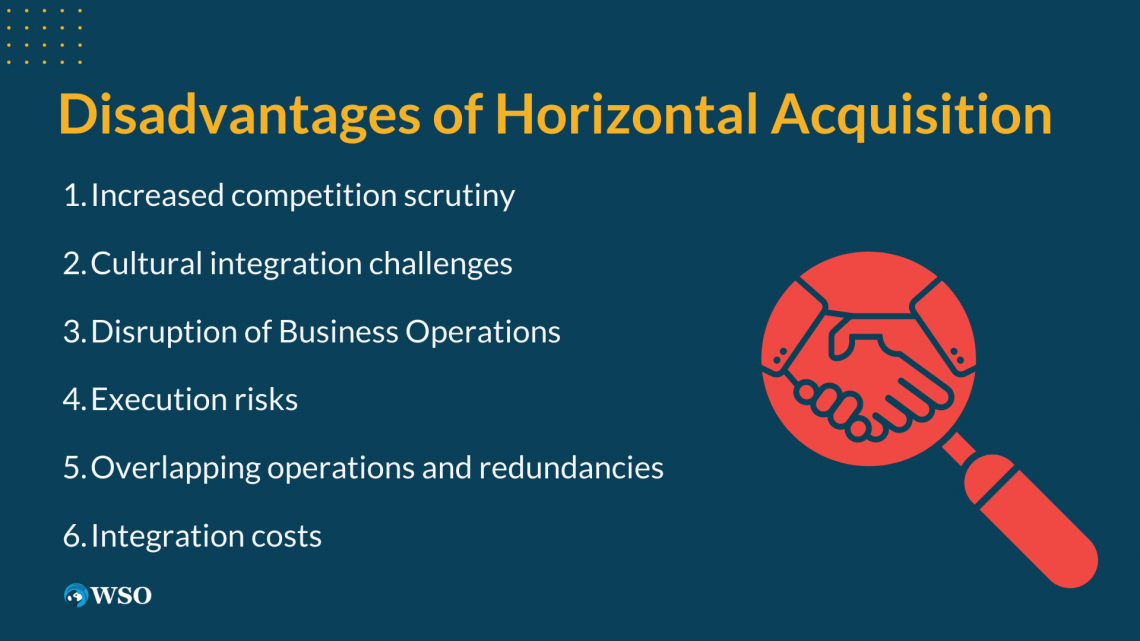Horizontal Acquisition
An acquisition type involves a company acquiring or merging with another company in the same industry or offering similar products/services.
What Is a Horizontal Acquisition?
A horizontal acquisition, often called a horizontal merger or takeover, is a strategic economic operation wherein a company buys out or merges with any other commercial enterprise operating in the same economy sector or offers similar items or services.

This type of acquisition aims to expand the acquiring company's market share, strengthen its competitive position, and achieve various synergistic benefits.
The horizontal acquisition process begins with identifying a suitable target company. The acquiring company typically looks for companies that complement its existing operations, possess valuable assets or intellectual property, or have a significant market presence.
Thorough market research and analysis are conducted to evaluate the target company's strategic fit, growth potential, and financial viability.
Once a potential target is identified, negotiations and due diligence take place. Legal and financial advisors play a crucial role in assessing the target company's financial health, legal obligations, contracts, and potential risks.

This step is crucial to determine the fair valuation of the target company and ensure regulatory compliance.
A definitive agreement is reached between the acquiring company and the target company if the negotiations are successful. The agreement includes the purchase price, payment schedule, and integration strategies.
The integration process follows the completion of the acquisition. This involves combining the operations, resources, and management of both companies.
The goal is to achieve synergy by eliminating duplicate functions, streamlining processes, and integrating systems and technologies.
Effective integration necessitates careful preparation, communication, and collaboration to minimize disturbance and ensure a seamless transition.
Key Takeaways
- Horizontal acquisition involves a company acquiring or merging with another company in the same industry or offering similar products/services.
- The process involves identifying a suitable target company, conducting due diligence, negotiating and reaching an agreement, and integrating the operations of both companies.
- The benefits of horizontal acquisition include increased market share, economies of scale, and diversification.
- Horizontal acquisitions can enhance profitability, market presence, and risk mitigation.
Horizontal Acquisition Types
Horizontal acquisitions can take various forms depending on the specific objectives and circumstances of the companies involved.

Here are some common types of horizontal acquisitions:
1. Competitor Acquisition
This type of horizontal acquisition involves acquiring a direct competitor in the same industry. A company can eliminate opposition, enlarge its market proportion, and boost its competitive position by acquiring a competitor.
It also provides access to the competitor's purchaser base, distribution channels, technologies, and intellectual property.
2. Product Line Extension
In this, a company acquires another company that offers complementary or related product lines. Increasing market share, product line, and product synergies are its objective.
For example, to provide a full variety of items to its clients, a company specializing in sports footwear can buy a company making athletic gear.
3. Market Expansion
Horizontal acquisitions can also be used to expand into new geographic markets. By acquiring a company operating in a different region or country, the acquiring company can quickly establish a presence and gain access to new customers and distribution networks.
Note
This type of acquisition allows the company to capitalize on local market knowledge, overcome entry barriers, and achieve economies of scale.
4. Supplier/Distributor Acquisition
Sometimes, a company may choose to acquire its suppliers or distributors horizontally. By integrating backward and acquiring suppliers, a company can secure its supply chain, reduce dependency on external suppliers, and gain more control over production costs and quality.
Similarly, acquiring distributors can help a company strengthen its distribution network, improve market reach, and streamline the supply chain.
This type of acquisition allows the acquiring company to leverage the acquired brand's reputation, customer loyalty, and brand equity to increase its market presence and competitiveness.
Advantages of Horizontal Acquisition
This form of merger or acquisition provides a host of benefits and can be instrumental in strengthening a company's market position.

Some of the advantages are described below:
1. Increased market share
The horizontal acquisition allows the acquiring company to expand its market presence by combining its operations with another player in the same industry.
2. Access to Resources and Intellectual Property
Horizontal acquisition provides access to additional resources, such as infrastructure, technology, and expertise, while also gaining control over valuable intellectual property assets of the acquired company.
3. Economies of Scale
Horizontal acquisitions provide economies of scale by eliminating duplication, consolidating operations, and increasing market power, leading to cost savings, improved efficiency, and enhanced competitive advantage.
4. Synergies and cost savings
By merging with a competitor, companies can achieve synergies and save costs. Consolidating operations, eliminating duplicate functions, and streamlining processes can improve efficiency and reduce costs.
5. Expanded product portfolio
Horizontal acquisitions enable companies to diversify their product or service offerings.
By acquiring a company with complementary products, the acquiring company can expand its portfolio and cater to a broader range of customer needs. This can lead to increased cross-selling opportunities and revenue growth.
6. Competitive advantage
Through these acquisitions, companies can gain a competitive advantage by eliminating a direct competitor from the market. This can result in increased pricing power, stronger negotiating positions with suppliers, and enhanced market positioning.
Disadvantages of Horizontal Acquisition
While these acquisitions can prove beneficial, it's essential also to consider the potential drawbacks that can accompany such a strategy.

These transactions may pose certain risks and challenges to a company, leading to unexpected complications or negative impacts.
Some of the disadvantages are:
1. Increased competition scrutiny
These acquisitions often attract regulatory scrutiny, particularly if the combined entity would result in a significant market concentration or reduced competition.
Obtaining regulatory approvals can be time-consuming and costly, and there is always a risk of the acquisition being blocked or conditioned.
2. Cultural integration challenges
Merging two companies with distinct organizational cultures can be challenging. Differences in management styles, work processes, and corporate values may lead to conflicts and difficulties in integrating the acquired company successfully.
3. Disruption of Business Operations
Disruption of business operations is disadvantageous due to integration challenges, cultural clashes, and potential loss of key talent.
4. Execution risks
Integrating two organizations is a complex process that requires careful planning and execution. Failure to effectively integrate systems, processes, and personnel can result in disruptions, loss of key talent, and operational inefficiencies.
5. Overlapping operations and redundancies
These acquisitions may lead to duplicate operations and redundancies in certain areas, such as sales, marketing, and administrative functions.
Consolidating operations and eliminating duplicates can be challenging; if not managed properly, it can lead to inefficiencies, conflicts, and employee resistance.
6. Integration costs
While horizontal acquisitions can result in long-term cost savings, there are significant upfront costs associated with integration. These include legal and advisory fees, rebranding expenses, IT system integration, and severance packages for redundant employees.
Horizontal Vs. Vertical Acquisition
While each type of acquisition involves the purchase of some other organization, they fluctuate in terms of their targets and their effect on the obtaining firm.

Understanding the distinctions between these two types of acquisitions is crucial for businesses seeking growth opportunities and improved market positioning.
| Basis | Horizontal Acquistions | Vertical Acquisitions |
|---|---|---|
| Definition | Acquisition of a company operating in the same industry | Acquisition of a company within the same supply chain |
| Types of integration | Lateral integration | Upward or downward integration |
| Competitive advantage | Eliminates direct competitors | Reduces dependence on external suppliers or distributors |
| Examples | Facebook acquiring Instagram or Disney acquiring 21st-Century Fox | A car manufacturer acquires a tire manufacturing company to secure a stable supply of tires. |
Horizontal acquisitions facilitate market consolidation, allowing firms to increase their market share, eliminate competitors, and achieve economies of scale.
Meanwhile, vertical acquisitions enable companies to strengthen their supply chain, control critical inputs, and improve operational efficiency.
Ultimately, the choice between horizontal and vertical acquisitions depends on various factors, such as a company's growth objectives, industry dynamics, and internal capabilities.
Conclusion
Horizontal acquisitions involve acquiring or merging companies operating in the same industry or offering similar products or services. Companies can increase their market share, realize economies of scale, and strengthen their competitive position by making this strategic step.

While the process requires careful planning and execution, successful horizontal acquisitions can generate significant value and propel the growth and success of the acquiring company.
It's worth noting that some horizontal acquisitions may involve a combination of competitor, product line, brand, etc. types of acquisition, depending on the specific goals and strategies of the acquiring company.
Each type of horizontal acquisition presents unique opportunities and challenges, and companies must carefully evaluate their strategic fit, financial implications, and integration plans to ensure a successful and mutually beneficial outcome.
It is crucial for companies considering a horizontal acquisition to carefully evaluate the potential advantages and disadvantages to make informed decisions.
Depending on the specific aims of the purchasing organization, each form of acquisition has advantages, difficulties, and strategic goals.




or Want to Sign up with your social account?